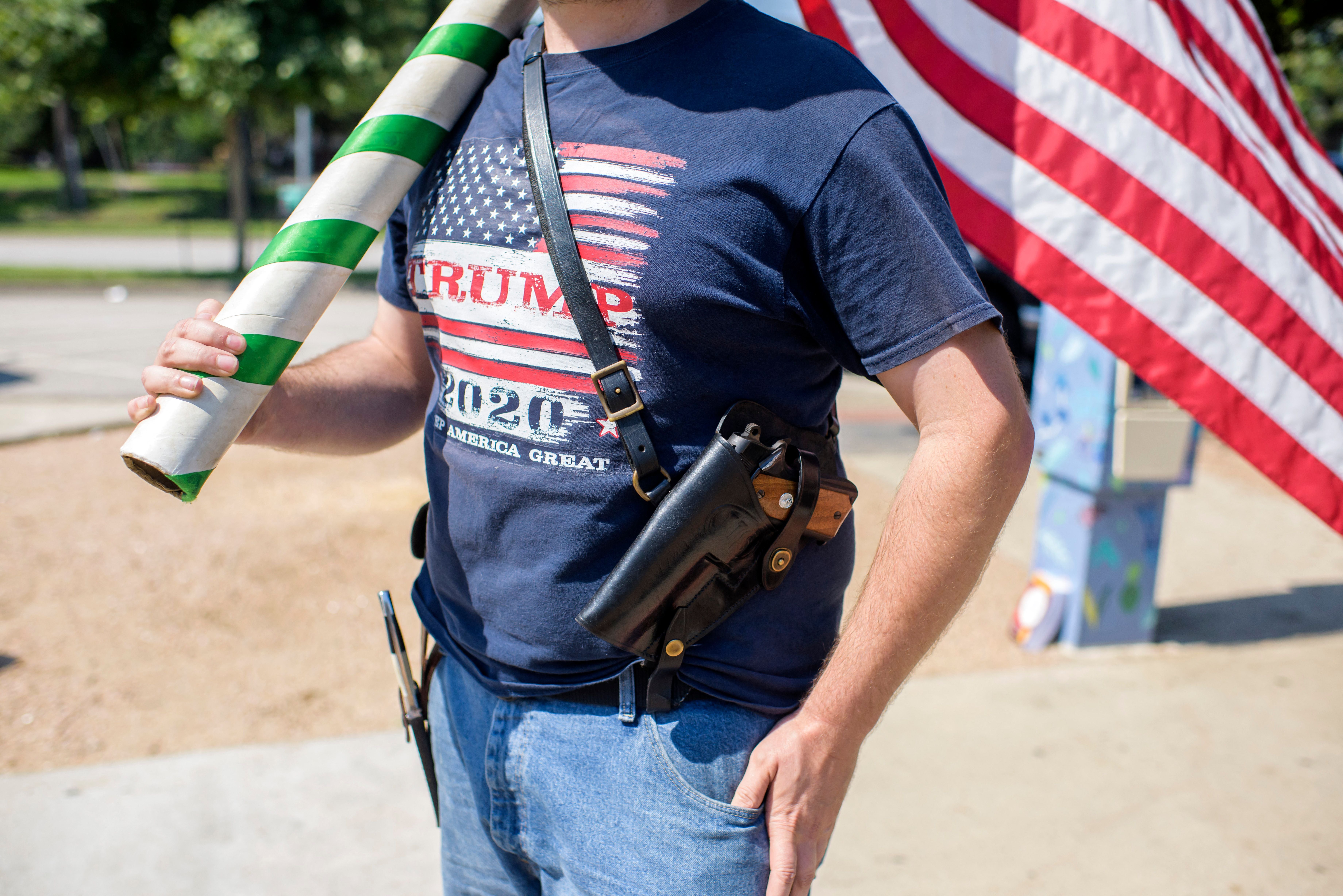Republicans insist most gun violence happens in Democratic cities – the figures tell a different story
Conservatives like to paint Democratic states as crime-ridden warzones, but gun violence is worse in red states, Josh Marcus writes


Your support helps us to tell the story
From reproductive rights to climate change to Big Tech, The Independent is on the ground when the story is developing. Whether it's investigating the financials of Elon Musk's pro-Trump PAC or producing our latest documentary, 'The A Word', which shines a light on the American women fighting for reproductive rights, we know how important it is to parse out the facts from the messaging.
At such a critical moment in US history, we need reporters on the ground. Your donation allows us to keep sending journalists to speak to both sides of the story.
The Independent is trusted by Americans across the entire political spectrum. And unlike many other quality news outlets, we choose not to lock Americans out of our reporting and analysis with paywalls. We believe quality journalism should be available to everyone, paid for by those who can afford it.
Your support makes all the difference.You would think, hearing many prominent Republicans discuss America’s gun violence epidemic, that most shootings only occur in large cities in Democratic states like Los Angeles and New York, proving that gun laws make no difference, or that Black Lives Matter protests had somehow led to an end of effective policing.
After a gunman killed 21 people at an elementary school in the rural border town of Uvalde, Texas, officials there still pointed to Chicago as the place where gun violence was really happening, despite Illinois’ more stringent gun laws.
"We need to realize that people who think that ‘maybe if we could just implement tougher gun laws, it’s going to solve it.’ Chicago and LA and New York disprove that thesis. And so if you’re looking for a real solution, Chicago teaches that what you’re talking about is not a real solution," Texas governor Greg Abbott said.
“A license isn’t going to change this. If a bad guy wants to get a gun, he’s gonna get a gun. It’s proven over and over again. Look at Chicago,” Uvalde’s mayor, Republican Don McLaughlin, said the day after the shooting. “You can’t even buy a gun in the city of Chicago, but they have shootings every weekend.”
According to experts, however, thinking about gun violence like this misses huge parts of the picture. It’s an epidemic that touches rural communities just as much as urban ones, with disproportionate impacts on racial minorities, and contrary to the popular idea, Republican-led states.
Between 2019 and 2020, the latest years for which comprehensive federal data is available, homicides rose nearly 30 per cent, the largest one-year increase in killings in US history.
“This was an increase across the board, in red and blue states, big cities and small towns alike,” according to Hanna Love, a research associate at Brookings who studies gun violence.
And gun violence was driving this trend: three in four homicides during this period involved guns, the highest ratio in US history, according to a RAND analysis. Firearms killed roughly 124 people a day during this period, and were the leading cause of death for young people under age 25. Youth were nearly ten times more likely to be killed by a gun than by Covid in 2020.
This violence wasn’t evenly felt, however. Texas had the highest number of gun deaths in 2020.
Meanwhile, Republican, largely rural states with low populations — Mississippi, Louisiana, Wyoming, Missouri, Alabama, and Alaska — had the six highest per capita rates of gun deaths. These states also had the highest rates of gun ownership for the same period. In Mississippi, about half of adults live in a household with a gun.
In 2020, the per capita murder rate was 40 per cent higher in states Donald Trump won during the 2020 election, according to a recent report from the centre-left thinktank Third Way.
“Murder rates are far higher in Trump-voting red states than Biden-voting blue states. And sometimes, murder rates are highest in cities with Republican mayors,” the reports authors write. “Yet there is barely a whisper, let alone an outcry, over the stunning levels of murders in these and other places.”
The states with the lowest rates of gun deaths — Hawai’i, Massachusetts, and New Jersey — all were Democratic and have stricter gun laws.
Rural America, which struggled with economic challenges, mental health, and social dislocation just as much as anywhere else during the pandemic, saw nearly the same spike in homicides as cities did in 2020, with deaths rising by 25 per cent, the largest increase since CDC began tracking the figure.
“It was like people lost their ever-lovin’ minds,” Rebecca McCoy, a prosecutor in Arkansas’s rural White County told the Wall Street Journal, of the unprecedented rise in rural violence.
And it’s a trend that’s been a long time coming.
Between 2008 and 2014, 21 of 33 states with sufficient gun violence data showed equal or greater gun violence in rural areas compared with large metro areas, according to an analysis from the John Jay College of Criminal Justice — even in favoured GOP punching bags like Californa and Illinois.
Part of the explanation for these trends has to do with the intersection of rural gun access and mental health.
The majority of gun deaths in recent years, 54 per cent, are not mass shootings or the gangland-style killings you might hear about on the local news. They are suicides.
And the majority of suicides, 53 per cent, involve a gun, according to research from the Kaiser Family Foundation (KFF).
The foundation found that the top 10 states with highest rate of gun suicides — Wyoming, Arkansas, Montana, New Mexico, Idaho, Colorado, South Dakota, Utah, West Virginia, and Arkansas — are also largely rural and largely Republican, with easy access guns.
“We continue to see that the states with more gun provisions have lower homcide and suicide rates,” KFF’s Nirmita Panchal said.
Rural Americans die by suicide with a firearm as much as five times more often than as those in urban areas, according to Everytown for Gun Safety. Meanwhile, densely populated urban areas in Massachusetts, New Jersey, New York, and Washington, DC, have the lowest rates of gun suicide.
Rural areas often have inadequate mental health infrastructure, even as two in three adults in rural America told the American Farm Bureau Federation in December 2020 they felt increasing mental health challenges.
Research from the University of Washington, studying rural communities in Colorado, Illinois, Kansas, Oregon, Utah, and Washington indicates that rural Americans have better gun training earlier on, and start bearing arms sooner but also have “significantly” higher rates of gun suicide.
It illustrates why gun policy interventions need to move beyond just considering cities, according to the study’s lead author, epidemiology professor Ali Rowhani-Rahbar told Oregon Public Broadcasting.
“There are some programs out there, but many of them are geared towards urban settings,” he said.
That is not to say rural America, with its largely white population, is the only group facing disproportionate violence.
In 2020, about 38 per cent of gun homicide victims were young Black men, even though they make up just 2 per cent of the total US population. More than half of Black teens who died in 2020 were killed by gun violence, according to Johns Hopkins University researchers. Black males between the ages of 15 and 34 were over 20 times more likely to die by gun homicide than white people.
The various trends of disproportionate violence converge in the cities with the highest gun homicide rates: Jackson, Mississippi; Gary,Indiana; St Louis, Missouri; New Orleans, Louisiana; and Memphis, Tennessee. They all have large Black populations, and they’re all in Republican states with minimal gun laws.
According to Ms Love, the Brookings scholar, there’s a “negative feedback loop” at work with urban gun violence. It’s often concentrated in historically marginalised areas, prompting further social deterioration and disinvestment. She’s found in her research that urban gun violence tracks closely with poverty and areas historically excluded from federal loan programmes.
“When you look at previously redlined areas, these also tend to be places that have the concentration of gun violence today,” she said. “Really what happened is, intentionally discriminatory housing policies, propogated by the federal goverment kind of created these communities that were to be predominantly Black, starved of private and public investment, and the kind of institutions that keep people safe.”
Mary Jane Meadows is a Tupelo, Mississippi-based activist, who has worked with groups like March for Our Lives and Indivisible to rally people around stopping gun violence in Mississippi, though it can be difficult in a deep-red state like hers.
“It is a religion. We are in the minority because people cling stubbornly to their right,” she said, describing state legislators who “will just support gun rights and the Second Amendment until they’re blue because that’s their voting base. That’s the only blue thing about the place.”
“It’s an epidemic,” she added. “It is a health crisis. That’s what we’d like to see it treated as, a public health emergency.”
She’s hoping building multi-racial coalitions across the state to register voters and talk about gun violence might change things.
“We can do that,” she said. “We have the people. We have to go get them out of the woods and tell them what would embolden them to get out and vote.”
For all the division around guns, stopping gun violence appears to be one of the few things that national leaders of both parties agree is a priority.
In June, President Joe Biden signed a bipartisan gun deal, the Bipartisan Safer Communities Act, the first such legislation in decades, and one of the few national initiatives backed by both parties during his term.
Kaiser Family Foundation’s Ms Panchal was especially glad to see the deal’s investments in mental health treatment.
“This includes additional funds for trauma support to assist these children who are being exposed to gun violence, whether it’s through school shootings or gun violence in their community,” she said. “There’s a lot of research into the importance of providing mental health care in schools because it is a more feasible way to reach children, and I think that this investment through the Bipartisan Safer Communities Act acknowledges the effectiveness of providing this care at school.”
The legislation didn’t go far enough for many, and invested money in school police even though, as The Independent reported, they’ve been shown to be ineffective and often racist. But it was a recognition, however rare, that gun violence touches everyone. It’s a dose of reality that’s sorely needed in a gun debate that’s often twisted far away from the truth.